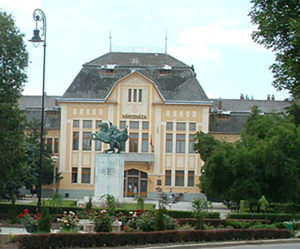About Karcag
The typical county town of Nagykunság with its 23.000 inhabitants became the cultural, commercial, health, education center of this area.
The History of the center of Nagykunság dating back to Mongol devastation to 13th century. The Cumans are from the branch of Kipchak Turks. After settling in Hungary Cumans became a Christian and had integrated into the Hungarian orders of society. These privileged people served the King as soldiers, they became Hungarian, and their ancient language, some part of their culturestill lives on today in geographical names, words and tags.
The large boundary of cities in Nagykunság was evolved during theTurkish occupation in the 17th century by annexing the territory of ruined villages and its remained inhabitants. That is why we call this micro area „Hatkunság”, as since then only six town was revived in the 18th century. The lifestyle of these plainsmen was caraterized with animal husbandry, grazing and agriculture in toft environment.
This structure of production provided the rank of the country town for centuries. There is a variety of cultural activity in the town. Besides the exhibitions of Stephen Györffy Nagykun Museum, the Alexander Kantor Pottery House and Nagykunság Country House you can visite the Csokonai City Library and Arts Centre of Déryné. In August at the Nagykunsági Culture Days there area lot of tradition-based programs during the Hungarian statehood celebration. The society of Karcag is multivarious and its residents are proud of their past, their traditions. The protestant affection of Hungarian Kumans is demonstrated with the Presbyterian Church on the Kossuth square with its romantic style, the catholic presence (they were settled in by the Qeens command) attested by the beautiful catholic church. The early presence of greek traders proved by the beautifuls iconostasis in the greek church.

The city has serious art history. It is famous for its pottery. Here lived and worked the Kossuth Prize winner Alexander Kantor, this kind of manufacture is still alive nowdays. In this town creates his works Sándor Györfi, the Munkácsy Prize-winner sculptor whose dreamed bronze statues decorate the public places in the towns and villages. Near by the highway number 4. on the Kis-hegyesbori hill there is a memorial which commemorates the settlement of Kumans. The city's Symphony Orchestra, Salon Orchestra, the City Choir and String orchestra contributes to strengthen the colorful music scene.
Karcag is the southern gateway of Hortobágy National Park. The Hungarian Plain with its windmills, preserved areas, never-ending sandy tracks and the five-hole Zador Bridge is a feast to the eye. The thermal spa of Karcag welcomes you and the swimming pool offers relaxation and healing for visitors. The wildlife is rich in small animals provides the hunters to enjoy their hobby. The hungry people can meet and taste the splendid regional culinary delights.
